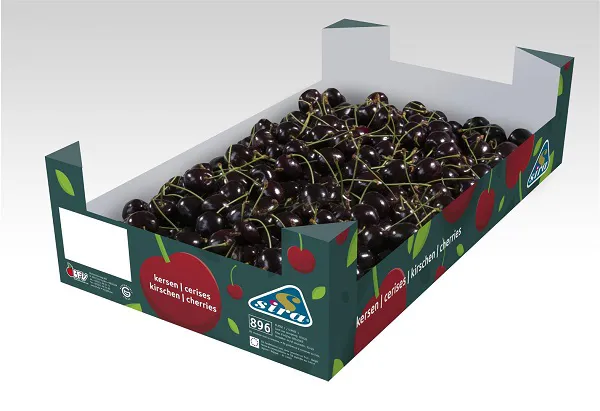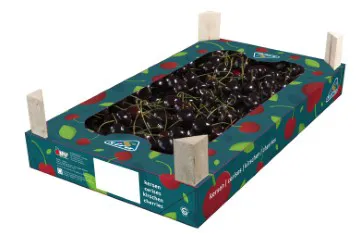The first early cherries were auctioned at the beginning of June already. The serious volumes of big cherry varieties must, however, still arrive. These are cherries like the Samba, Kordia, Regina, and Sweetheart. So says Diether Everaerts of Belgische Fruit Veiling (BFV). This is the largest fruit growers organization in Belgium. It has a domestic market share of about 40%. The first Sambas were expected in mid-June. Kordias will follow these.

BFV introduced new packaging for Sira cherries
Regina cherries will come onto the market at the start of July, and finally, the Sweetheart in late-July. At the beginning of June, Diether indicated that the market and price formation was well underway. “The market’s very empty,” Diether says. He’s determined that cherry production throughout Europe suffered frost and rain damage. Less volume is, therefore, available. With some varieties, possibly only 50% will be harvested. In Belgium too, there was a lot of rain in February.
Dry weather followed this, with night frost in April and May. This caused problems during the blooming phase, and the cherries were damaged. Last year, BFV harvested a record volume of 3.3 million cherries. This year’s forecast is clearly far lower. The total anticipated 2020 BVK volume lies at 2.2 to 2.3 million kg. For some varieties, a harvest of only 60% of the normal amount’s expected.
Not intended
“The market’s optimistic, but the quality and sizes must be there too.” The persistent dry weather could compromise sizes, admits Diether. “The cherries started coloring unevenly on the trees, while they weren’t yet of the perfect size. That means the early varieties such as the Burlat and Samba have a main size of 24-26 mm. That’s not the intended size. If the cherries stay small, good average prices can’t be reached.”
The cherries sizes are, of course, always dependent on natural conditions, says Diether. But he’s found that larger cherries are generally more popular. A large cherry is 28+ mm, but there’s a market for even larger ones too. “In recent years, we’ve noticed that for commercially attractive varieties, we sometimes go to 30, 32, and even 34 mm, depending on the season.”
BFV sells not only large volumes of well-known cherry varieties but also smaller volume cherries. During the season, for example, a collection of various lesser-known types of softer, fleshier cherries are brought on the market under the name Juno. They are currently auctioning the early Burlat in this grouping. The more obscure, smaller hard cherries are grouped similarly, under the name, Freya.

New packaging ensures recognisability
Continuity
Some of the cherries sold via BFV go to the Dutch and French wholesale channels. But, by far, the most find their way to the Belgian market, especially the retail sector. Diether’s seen that production recognition’s vital for retail continuity. That’s why BFV aims to harvest more than half the cherries from protected cultivation. At the moment, around 25 to 30% comes from protected farms. Costs play a role here - investment in a single hectare can quickly reach €40.000.
“A major advantage of protected cultivation is that you’re not affected by extreme weather conditions - not excessive rain or extreme heat.” That creates a more constant supply that attracts retailers. “You can only get a foothold in the supermarkets is you have a sure supply over a specific period. They mustn’t have to switch to overseas suppliers’ programs,” explains Everaerts. Belgian cherry growers are also trying to extend the season with new varieties. “Not every variety is equally promising. Some varieties have disappeared over the last ten years.”
“But, there are also important varieties, like the Kordia and Regina. They’ve been around for at least ten years. They seem to be the best. There isn’t currently a single variety that can replace these.” Packaging’s one way to improve recognition. BFV works with two brands. The very best fruit comes onto the market under the Truval label. The top, consistently high-quality ones under the Sira brand. BFV recently introduced new packaging for the Sira cherries. “It’s good to create a recognizable brand. You can then better meet the client’s demand for continuity and uniformity,” Diether concludes.
Voor meer informatie:
Diether Everaerts  Belgische Fruitveiling
Belgische Fruitveiling
Montenakenweg 800
3800 St. Truiden
+32 11 69 34 11
diether.everaerts@bfv.be
www.bfv.be
